Daikaku-ji|大覚寺
Overview
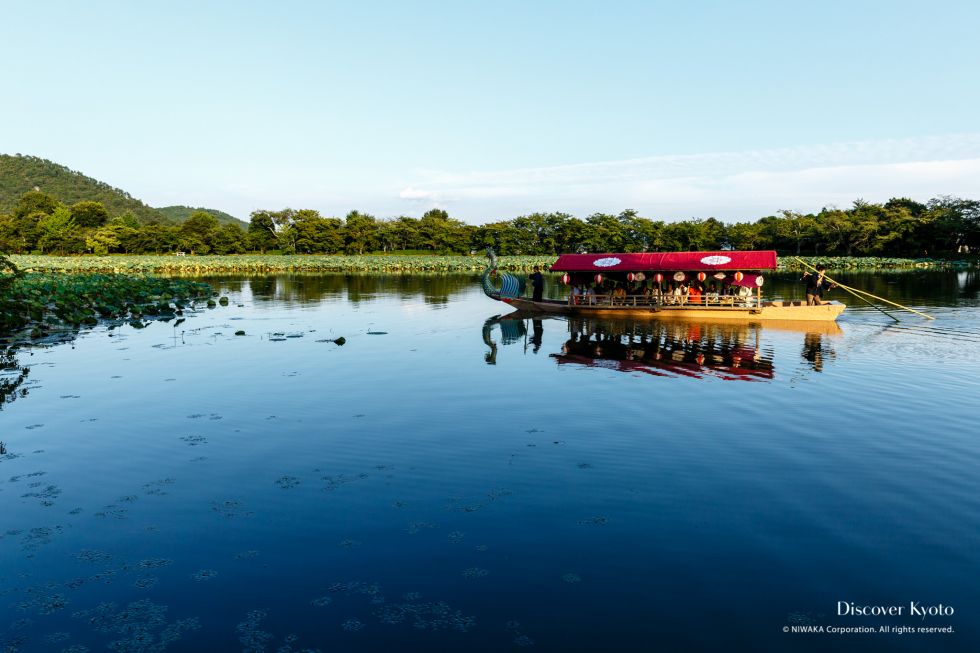
Intrinsically connected to the history of Imperial rule in Japan, Daikaku-ji was originally the villa of Emperor Saga (786 – 842). It became a temple after his death on orders from his daughter Empress Masako, and later served as a retirement palace. Though the original buildings inhabited by emperors were destroyed over time, they were replaced by structures transplanted from various locations. The man-made Osawa Pond on the grounds is one of the oldest surviving Heian Period garden ponds and was designed to look best when seen from a boat, which the temple sometimes provides for guests during festival periods. Because of its history as a villa, the layout of Daikaku-ji is slightly different than what you may expect from the average temple. The principal objects of worship at Daikaku-ji are the Five Wisdom Kings (Godai Myō’ō), particularly Fudō Myō’ō, and the most valuable treasure at the temple is a copy of the Heart Sutra written by Emperor Saga himself. The ikebana school Saga Goryū also calls this temple its headquarters, and you can usually see a beautiful display of floral arrangements on your trip.
Because of its history as a villa, the layout of Daikaku-ji is slightly different than what you may expect from the average temple.
Features
Living Flower Arrangements
There exists a legend that Emperor Saga once arranged chrysanthemums in order to present them to the court. Based on this, Daikaku-ji serves as the headquarters to the ikebana Saga Goryū school. You can usually see a beautiful display of floral arrangements on your trip in a long alcove running alongside the path to the temple’s reception entrance. There are several festivals throughout the year that also incorporate works from the Saga Goryū tradition, such as flower offerings or the Kadō-sai festival.
Villa Architecture
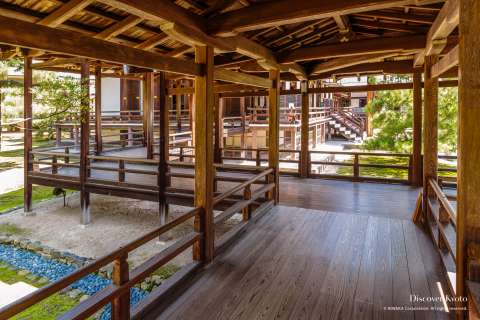
Because Daikaku-ji was originally an imperial villa, it has never possessed the more commonly seen temple style of architecture. Despite losing the majority of the original buildings over time, this aesthetic was preserved by replacing them with similar structures transplanted from other locations. Long, covered walkways open on all sides connect the buildings, and luxurious gold foil paintings cover the screens and walls. A richly decorated Chokushimon gate stands large at one end of the courtyard, only opened for envoys of the Emperor himself, and finely detailed carvings of flowers and nature can be found everywhere on the wooden walls, columns, and ceiling.
Godai-dō Hall
Serving as the main hall of Daikaku-ji and dating back to the Edo period, the Godai-dō houses the main objects of temple worship, the Five Wisdom Kings. Of the five, Fudō Myō’ō, the Immovable Wisdom King, is particularly venerated at Daikaku-ji. In addition to prayers, transcription sessions are held three times a month in which worshippers can copy the Heart Sutra with guidance from a monk, and shakyō sutra copying can be done self-guided on any day.
Heart Sutra
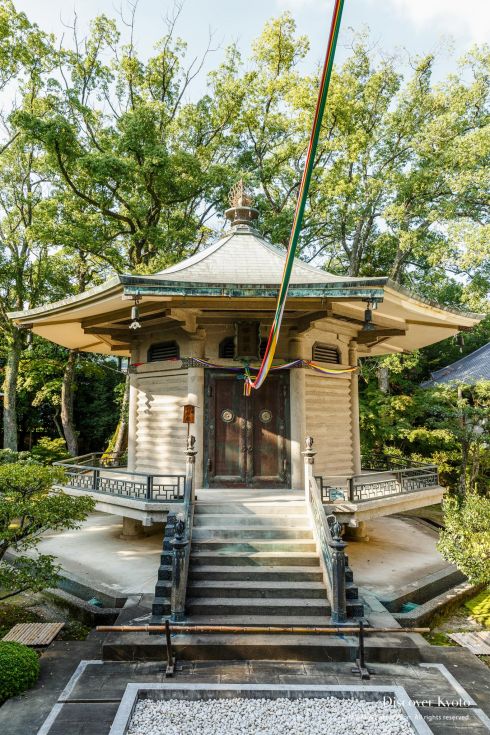
Housed within the Chokufū Shingyō-den behind the main hall is Hannya Shingyō (the Heart Sutra), said to be handwritten by Emperor Saga (786 – 842) himself. Legend has it that when a deadly sickness was sweeping the capital the famous monk Kōbō Daishi suggested the Emperor copy the Heart Sutra in response, which then brought an end to the epidemic. This venerable document is now housed in this keep and displayed to the public only once every 60 years, the most recent being in 2018. For now, visitors must content themselves with touching the five-colored rope hanging in the Mie-dō hall that connects the sutra’s power to the outside world.
Osawa Pond
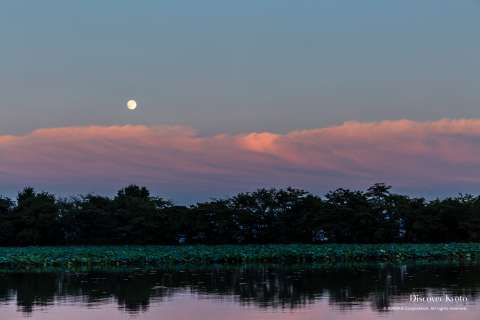
Actually older than the temple itself, Osawa Pond was designed by Emperor Saga at an unknown date. An artificial lake designed to be most lovely when viewed from a boat, it is the oldest of its kind remaining in Kyoto. Within the lake are two islands, one of which is referred to as the Chrysanthemum Island (Kikugashima). The lake has been featured in numerous poems of the day, and is particularly famous for moon-viewing and cherry blossoms. During these two periods the temple brings out two boats for visitors to ride in and enjoy the view of the lake, as well as the traditional boats themselves, which sport a dragon and waterfowl as their figureheads.
History
Before it became a temple, Daikaku-ji was an imperial villa called Saga Rikyū-in that belonged to Emperor Saga (786 – 842), the 52nd Emperor of Japan. Famous for establishing Kyoto as a cultural, artistic city after his father Emperor Kanmu designated Kyoto as the capital city, Emperor Saga took up residence in the villa upon his abdication from the throne in 823. At one point during his life when Japan was suffering from a plague, the famous Buddhist priest Kōbō Daishi suggested to the Emperor that he may be able to appeal to the deities by writing a copy of the Hannya Shingyō, the Heart Sutra. It is said that upon doing so, the epidemic was ended. This handwritten sutra is stored at Daikaku-ji still, available to be seen by the public once every 60 years.
Thirty four years after Emperor Saga’s passing his daughter, Empress Consort Masako, established Daikaku-ji as a temple in 876, giving it its name and its designation as a monzeki temple, one that would have imperial princes appointed as chief abbots. Emperor Saga’s grandson, Prince Tsunesada (dharma name and title: Gōjaku Nyūdō Shinnō), was placed as the first chief abbot. Several emperors used Daikaku-ji as their base of power after abdication over the years, such as Emperor Go-Uda (1267-1324). Over the years the original buildings were lost to time and fire, but during beautification projects such as the one carried out in the 17th century by Emperor Go-Mizuno’o saw them replaced with buildings from the Imperial Palace and other locations.
With 1,200 years of history, Daikaku-ji operates as an active training temple for young monks as well as a popular sight-seeing place. When Emperor Saga was living on the site he was famous for hosting cultural salons and performances, and in that tradition Daikaku-ji continues to be host to various events both classic and modern, such as fashion shows, concerts, and the filming of period dramas.
Events
February 3rd | Setsubun, Hoshi Matsuri |
|---|---|
April | Flower Arrangement Festival (Kadō-sai) |
August | Yoi Kobo Ritual |
September | Moon Viewing Party (Kangetsu no Yūbe) |
November (TBA) | Fall Light-up |
November | Saga Chrysanthemum Exhibition |
Access
Address
〒616-8411 京都府京都市右京区嵯峨大沢町4
| TEL | 075-871-0071 |
| FAX | 075-871-0055 |
| WEB | http://www.daikakuji.or.jp/english/ |
Admission
- General Admission: ¥500
- Junior High School: ¥300
- Primary School: ¥300
Hours
- General Admission: 09:00 - 17:00 (last entrance at 16:30)
- Closed: No closing days
Transportation
- From Kyoto Station ⇒ Sanin Main Line Train towards Kameoka ⇒ Saga Arashiyama Station ⇒ 15 – 20 minutes walking
- From Kyoto Station ⇒ Sanin Main Line Train towards Kameoka ⇒ Hanazono Station ⇒ City Bus Route 91 towards Daikaku-ji ⇒ Daikaku-ji Bus Stop ⇒ 2 minutes walking
- From Arashiyama Station ⇒ City Bus Route 28 towards Daikaku-ji ⇒ Daikaku-ji Bus Stop ⇒ 2 minutes walking
Gallery
-
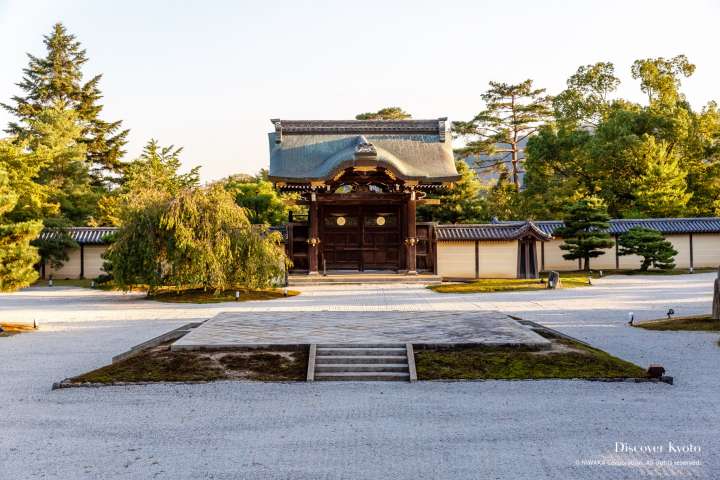



 +12
+12
